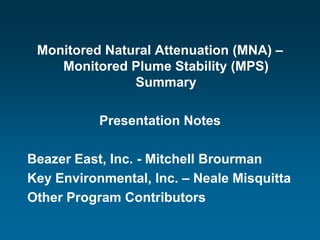
Beazer Mps Presentation Agency Support
- 1. Monitored Natural Attenuation (MNA) – Monitored Plume Stability (MPS) Summary Presentation Notes Beazer East, Inc. - Mitchell Brourman Key Environmental, Inc. – Neale Misquitta Other Program Contributors
- 2. MPS – Selected as Primary Remedy/Implemented – It’s Been Done Before MPS selected as the primary groundwater remedy at: Ritari Post and Pole Site in Sebeka, Montana American Creosote Works Site in Jackson, Tennessee Smeltertown Site in Salida, Colorado
- 3. MPS - Implemented MPS has also been implemented at: Former Koppers Site in Kansas Ctiy - Groundwater Champion International Site in Libby, Montana Former Koppers Site in Oroville, California - Groundwater Former Koppers Company Inc. Facility – Youngstown, Ohio – Groundwater and Sediments Koppers Superfund Site – Chareston, SC, sediments (and groundwater?) Koppers Company Inc. Facility – Florence, SC – groundwater. Typically linked with site institutional controls and deed restrictions
- 4. Creosote Sites – Kiilerich and Arvin Data from 44 creosote impacted sites in Denmark demonstraes the viability of naturally occurring processes for reduction of groundwater constituent concentrations (Kiilerich and Arvin (1996). Moreover, dissolved reoste concentrations are reduced below detection limits within 50 meters downgradient of the source.
- 5. Creosote Sites – Godsy and Goerlitz (1986) Godsy and Goerlitz report that natural attenuation of creosote compounds occurs downgradient of creosote sites. Concentrations of creosote compounds decrease in groundwater with increasing distacnce due to dispersion, sorption, and/or biological and abiotic degradation and because the cresosote or dissolved phase creosote compounds in the groundwate have reached an equilibrium with the presence of DNAPL creosote.
- 6. Naphthalene - Biodegradation U.S. EPA (Federal Register, Vol. 67, No. 106, June 3, 2002, p. 38238) made a preliminary determination not to regulate naphthalene with a National Primary Drinking Water Regulation because it occurs infrequently in public water supplies and when it does occur, it is not known to occur at levels of public health concern. EPA indicates that “usually naphthalene is not found in water because it evaporates or biodegrades quickly”.
- 7. UST Plumes Mace et al. (1997) Texas Bureau of Economic Geology Geological Circular 97-1 studied 605 underground storage tank sites and determined that, "Most benzene plumes (75 percent) caused by leaking underground fuel tanks are less than 250 ft long and impact an area of less than 49,000 feet squared as defined by the 10-ppb contour of benzene." The reason for the short plumes is natural attenuation including biodegradation. See attached. These results are consistent with the Livermore study (Rice et al., 1995). They studied UST releases in California and concluded that, "Plume length estimates showed that average site plume lengths rarely exceed about 250 ft."
- 8. Fuel Hydrocarbon Solute Plume Studies (cont’d) 1997 - Texas fuel hydrocarbon plume study Mace et al -- Texas Bureau of Economic Geology Evaluated historical data from 605 fuel sites Growing Unknown 3% 1% Shrinking 34% Stable 62% 75% of plumes < 250 feet long
- 9. Texas Plume Study Plume Length Growing Unknown 3% 1% Shrinking 34% Plume Mass (ave. concentration) Stable 62% Unknown Growing n = 219 1% Stable 14% 27% Shrinking n = 227 58%
